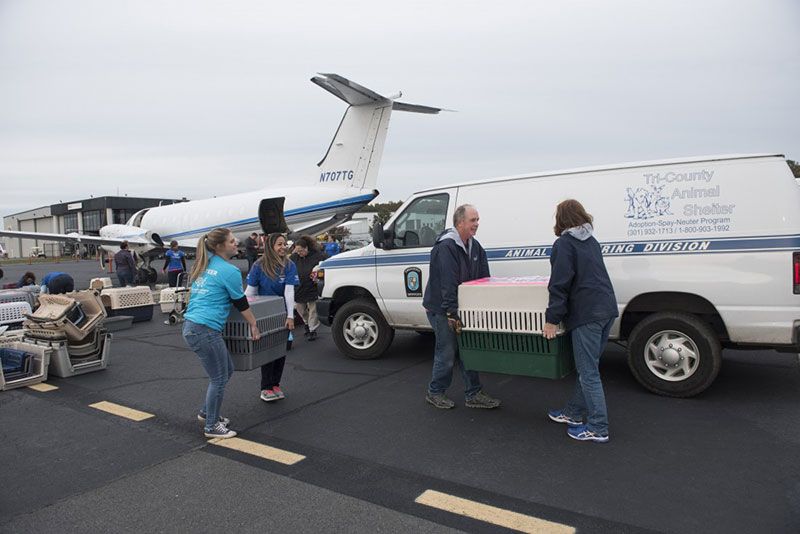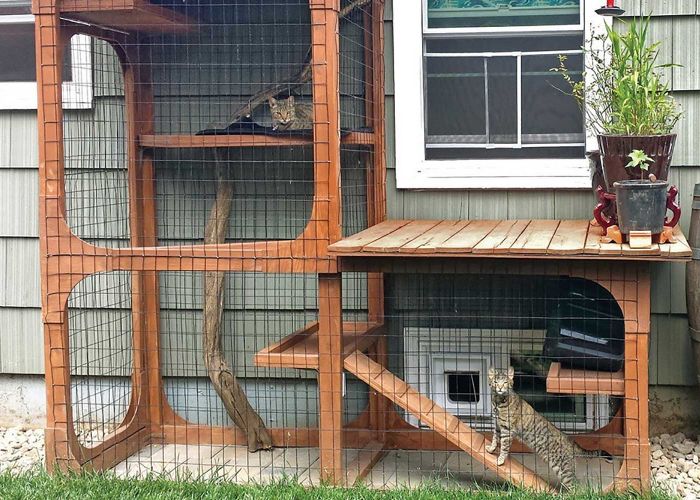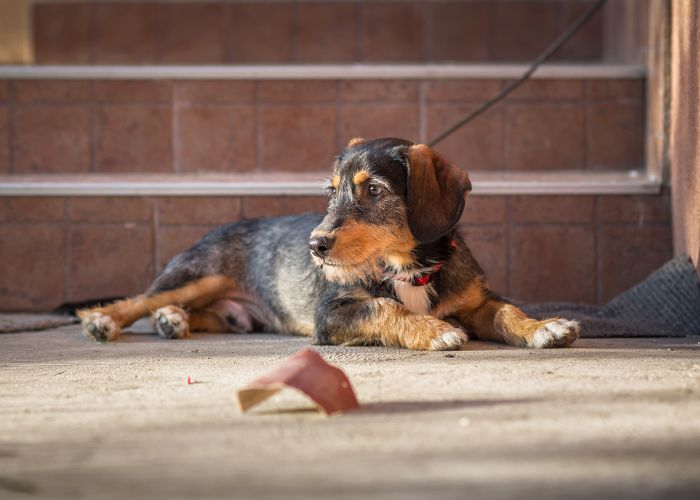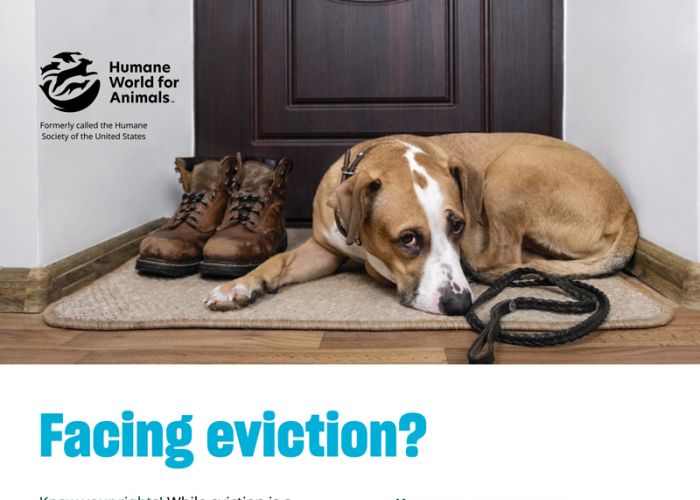Moving in the right direction
Best practices guidelines offer efficient, effective methods for transport program success

Anyone who’s ever tried to drive an uncooperative dog or cat to the vet knows how challenging companion animal transport can be. Naturally, the challenges (and dangers) increase when you’re transporting multiple animals over long distances.
But shelters and rescue groups increasingly find themselves doing just that, moving animals from overpopulated sending areas to destination regions where they’re in great demand, ideally reducing euthanasia and landing more animals in new homes. Transport programs have grown more complex in recent years, evolving to include both ground and air travel and organizations that serve as hubs, receiving animals from multiple areas and transporting them on via multiple agencies.
To help ensure that pets arrive safe and healthy, The Association for Animal Welfare Advancement (formerly SAWA) released a set of best practice guidelines for companion animal transport, which address everything from vaccinations and potty breaks to contingency plans for bad weather.
“The best practices are not minimum standards,” explains Brad Shear, executive director of the Potter League for Animals in Rhode Island and chairman of AAWA’s best practices committee. “If you look at this as an organization and say, ‘Well, we can’t meet these standards,’ we’re not saying you should stop, but you should certainly aspire to them. And we make it clear in the document there are certainly some activities that you just have to do, like complying with state law.”
In this edited interview with assistant editorial director James Hettinger, Shear and Kimberley Alboum, shelter outreach and policy engagement director at Humane World for Animals (who helped draft the emergency transport section of the document), discuss how the AAWA guidelines can increase positive outcomes for companion animals on the move.
Why is this document needed?
Brad Shear: The concern was that as this practice of transport grew, there were a lot of agencies not doing the best job of transporting animals, potentially doing harm, potentially even putting animals at risk. We wanted to make sure that this was going to be a strategy that all of us could still take advantage of. We’ve seen a lot of states pretty strictly regulate the practice, and there’s concern across the country that the activity could be regulated even more.
Kimberley Alboum: We needed a best practices document put together by animal welfare leaders across the country to ensure that pets are transported safely and humanely. And in addition to humane transport, our ultimate goal is to prevent the spread of disease. These best practices are aimed at keeping healthy animals healthy.
Shear: Our hope is to lift up the entire industry, get people to do what’s right, so that we don’t end up removing this as a potential lifesaving strategy. The goal is to keep this as an option, but it has to be done right or regulators who have concerns are going to prevent us from doing it.
Why has transport become so common?
Shear: When you look at places like where I live in the Northeast, especially around New England, we have had access to spay and neuter for many years, at low cost and very accessible. What we’re experiencing in the Northeast is a rapid decline in the number of animals coming in from our communities, but we have a great infrastructure for adoption and for animal care. So if we did not transport animals, we wouldn’t have that many to place in our communities. We have a great ability to save lives by placing animals from places where the supply is high and the demand isn’t as high.
The document really tries to encourage that these transport relationships are true partnerships between organizations, not just a transactional relationship where you send us an animal and we adopt him out. There should be a partnership beyond that. We’re sending funds back to the source shelters so they can build programs, and we support them in their efforts to reduce the population in their community.
The hope is that this strategy is really a temporary one, and that eventually there is just as much demand in the communities where animals are coming from as there is in the communities where they’re going, and that populations throughout the country are reduced. In some places we’re getting close to that, and in some places we’re further away.

Are the new modes of transportation for animals, like air transport and hubs, just a natural outgrowth of the practice becoming more common?
Shear: I think it’s that, and it’s also there are a lot of very innovative people in our industry who see problems from different perspectives. Personally, I’m not a pilot—I probably never would have thought you could put 100 dogs on a plane. I don’t know anything about the private plane industry or how you even would schedule your private plane to fly animals, but somebody out there who loves animals and understands planes came up with this idea. And when you’re going long distances it is much faster, and it can be more efficient.
There are cautions about doing it the right way, just like anything else, but it’s a way to move large numbers of animals. When you see something like a hurricane hit Puerto Rico, well, there’s no choice except to move those animals by plane.
Hubs, which are typically used in ground transport, have enabled us to safely transport animals over longer distances. Again, it increases safety and efficiency for animals being moved. As there’s more success, we’re moving them longer distances, and that requires different ways of moving animals.
I think as an industry we’re constantly refining how we do this. It speaks well of the people who work in the industry; we’re constantly trying to do a little bit better.
Do you have a general sense of how things are going in terms of how animals are treated during transport efforts?
Alboum: I think we’re moving in the right direction. What we’re seeing now is shelters are collaborating with each other to do transfers, which is really exciting. There is a significant number of large transport groups and transport-only rescue groups that are coming into the fold.
Transport now, it’s about saving lives; it’s about diversifying the population in animal shelters across the country. And I think that some groups can get caught up in the numbers. What this best practices document does is it brings the groups back to the individual: Are they safe? Are they comfortable? What do they need in order to take this journey?
Shear: I think there are some great organizations that are focused on this and are doing it right, following every rule, making sure they understand the requirements of every state that they’re traveling into (which can vary widely), and transporting animals in safe and humane ways. And there are groups that are not as cautious that are still transporting animals in conditions that are not ideal, and are not making sure that the animals they’re transporting from state to state are carefully examined and have the right paperwork that states require for interstate transport.
As the industry lifts up, then you start seeing organizations talking to the ones who are not doing the right thing, saying, “Hey, don’t ruin it for everybody,” because when the state veterinarians see animals with diseases that your state doesn’t normally see come into the state, they’re going to pass legislation that makes it more difficult for everyone or in some cases makes it nearly impossible to move animals.
How do you hope organizations will use this document?
Shear: We really want it to be a living document. I think the best way to use it is to share it with your team, everyone involved in this function in the organization. And get together and say, “Where do we feel like we are doing this? Where do we feel like we are not? Is it possible for us to improve our operations? How do we do that and start creating pathways to do a better job of what we’re all doing?”
Sometimes that’s going to take time; sometimes you have to create a plan for that; and sometimes you sort of put a goal up on the wall and say, “Here’s where we want to get to, and we can’t do it today, but we really want to think about how we can be the best at what we do.” My hope is that that is a goal for everyone in the industry: We should all hope to be the best at what we do.
Alboum: While some of the standards are aspirational, I think that the way that this document is going to be used is in the way that we have already begun to use it at the HSUS. We’ve sent it out to all of our partner groups and all of our state directors so that everybody knows that these are the standards that we support, that we encourage. I see it being used by shelters across the country, to refer to: How many people do you need to drive 25 dogs across the country? What do you need to load a plane? What are the best practices for food and water before you fly a mother cat with kittens? All of these things are addressed in that document.
Shear: You can narrow your focus if it’s too overwhelming. I don’t think we’re saying to anybody, “Tomorrow you have to do all of this.” At the very minimum, you need to comply with state and federal law. So if you’re not getting pet certificates and rabies vaccinations for the animals you’re transporting, you need to do that.
Other than legal compliance, start with the thing that you think is most achievable; start building momentum. And, like anything else, when you achieve that piece, celebrate that success with your board and your staff and your volunteers.
What do you see as the future of transport?
Shear: It’s very hard to predict, but I think it’s here for a while. There’s a lot of infrastructure built up around it. Our hope is that the routes become more efficient. There are a lot of people doing transport; they’re all in their little bubbles. There isn’t a central place you can go where you can say, “Here’s a truck that’s going from Mississippi to Pennsylvania,” and somebody says, “Well, I’m in South Carolina, and I can take some dogs,” so the dogs go half as far. The shorter distance that animals can travel, the better. I think the near future is hopefully that we get more efficient and start finding ways to have shorter routes, finding ways for organizations to connect with each other better.
Alboum: What’s nice about these transport guidelines is they also outline flight, and I think that the future of transport is going to be air, because we’re reaching deeper and deeper into these pockets of population disparity, we’re going further into rural communities. In some cases, we’re even going into other countries. I think we’re going to start to see transport taper off in the next five to 10 years, but the very last aspect of it that’s going to taper off is going to be the flight.
LEARN MORE: Check out the Association of Shelter Veterinarians' video on animal relocation and transport.







